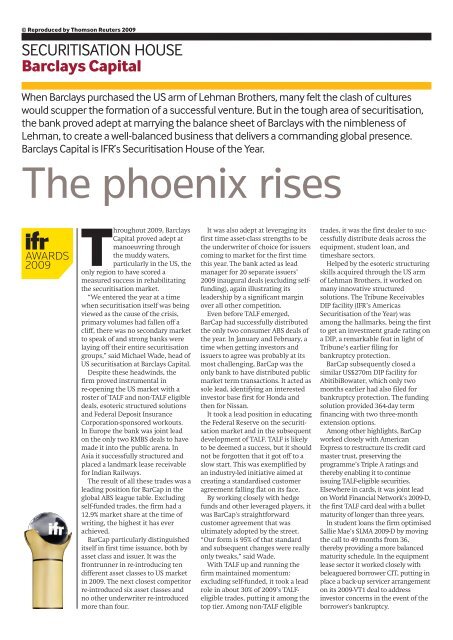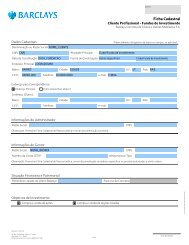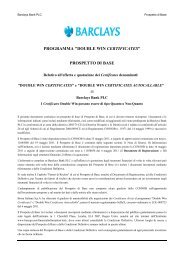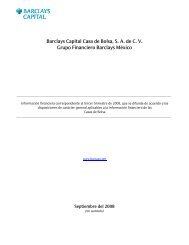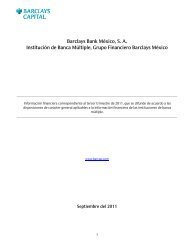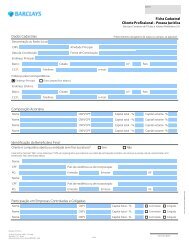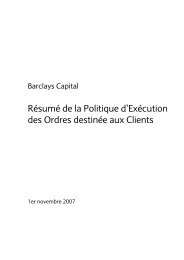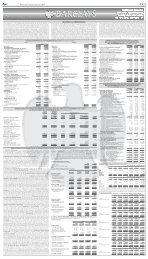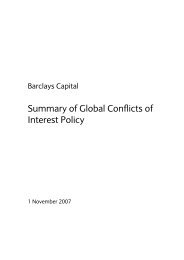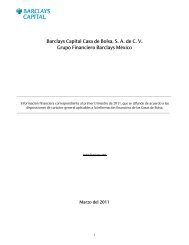IFR Awards 2009 (PDF) - Barclays Capital
IFR Awards 2009 (PDF) - Barclays Capital
IFR Awards 2009 (PDF) - Barclays Capital
Create successful ePaper yourself
Turn your PDF publications into a flip-book with our unique Google optimized e-Paper software.
© Reproduced by Thomson Reuters <strong>2009</strong><br />
SECURITISATION HOUSE<br />
<strong>Barclays</strong> <strong>Capital</strong><br />
When <strong>Barclays</strong> purchased the US arm of Lehman Brothers, many felt the clash of cultures<br />
would scupper the formation of a successful venture. But in the tough area of securitisation,<br />
the bank proved adept at marrying the balance sheet of <strong>Barclays</strong> with the nimbleness of<br />
Lehman, to create a well-balanced business that delivers a commanding global presence.<br />
<strong>Barclays</strong> <strong>Capital</strong> is <strong>IFR</strong>’s Securitisation House of the Year.<br />
The phoenix rises<br />
Throughout <strong>2009</strong>, <strong>Barclays</strong><br />
<strong>Capital</strong> proved adept at<br />
manoeuvring through<br />
the muddy waters,<br />
particularly in the US, the<br />
only region to have scored a<br />
measured success in rehabilitating<br />
the securitisation market.<br />
“We entered the year at a time<br />
when securitisation itself was being<br />
viewed as the cause of the crisis,<br />
primary volumes had fallen off a<br />
cliff, there was no secondary market<br />
to speak of and strong banks were<br />
laying off their entire securitisation<br />
groups,” said Michael Wade, head of<br />
US securitisation at <strong>Barclays</strong> <strong>Capital</strong>.<br />
Despite these headwinds, the<br />
firm proved instrumental in<br />
re-opening the US market with a<br />
roster of TALF and non-TALF eligible<br />
deals, esoteric structured solutions<br />
and Federal Deposit Insurance<br />
Corporation-sponsored workouts.<br />
In Europe the bank was joint lead<br />
on the only two RMBS deals to have<br />
made it into the public arena. In<br />
Asia it successfully structured and<br />
placed a landmark lease receivable<br />
for Indian Railways.<br />
The result of all these trades was a<br />
leading position for BarCap in the<br />
global ABS league table. Excluding<br />
self-funded trades, the firm had a<br />
12.9% market share at the time of<br />
writing, the highest it has ever<br />
achieved.<br />
BarCap particularly distinguished<br />
itself in first time issuance, both by<br />
asset class and issuer. It was the<br />
frontrunner in re-introducing ten<br />
different asset classes to US market<br />
in <strong>2009</strong>. The next closest competitor<br />
re-introduced six asset classes and<br />
no other underwriter re-introduced<br />
more than four.<br />
It was also adept at leveraging its<br />
first time asset-class strengths to be<br />
the underwriter of choice for issuers<br />
coming to market for the first time<br />
this year. The bank acted as lead<br />
manager for 20 separate issuers’<br />
<strong>2009</strong> inaugural deals (excluding selffunding),<br />
again illustrating its<br />
leadership by a significant margin<br />
over all other competition.<br />
Even before TALF emerged,<br />
BarCap had successfully distributed<br />
the only two consumer ABS deals of<br />
the year. In January and February, a<br />
time when getting investors and<br />
issuers to agree was probably at its<br />
most challenging, BarCap was the<br />
only bank to have distributed public<br />
market term transactions. It acted as<br />
sole lead, identifying an interested<br />
investor base first for Honda and<br />
then for Nissan.<br />
It took a lead position in educating<br />
the Federal Reserve on the securitisation<br />
market and in the subsequent<br />
development of TALF. TALF is likely<br />
to be deemed a success, but it should<br />
not be forgotten that it got off to a<br />
slow start. This was exemplified by<br />
an industry-led initiative aimed at<br />
creating a standardised customer<br />
agreement falling flat on its face.<br />
By working closely with hedge<br />
funds and other leveraged players, it<br />
was BarCap's straightforward<br />
customer agreement that was<br />
ultimately adopted by the street.<br />
“Our form is 95% of that standard<br />
and subsequent changes were really<br />
only tweaks,” said Wade.<br />
With TALF up and running the<br />
firm maintained momentum:<br />
excluding self-funded, it took a lead<br />
role in about 30% of <strong>2009</strong>’s TALFeligible<br />
trades, putting it among the<br />
top tier. Among non-TALF eligible<br />
trades, it was the first dealer to successfully<br />
distribute deals across the<br />
equipment, student loan, and<br />
timeshare sectors.<br />
Helped by the esoteric structuring<br />
skills acquired through the US arm<br />
of Lehman Brothers, it worked on<br />
many innovative structured<br />
solutions. The Tribune Receivables<br />
DIP facility (<strong>IFR</strong>’s Americas<br />
Securitisation of the Year) was<br />
among the hallmarks, being the first<br />
to get an investment grade rating on<br />
a DIP, a remarkable feat in light of<br />
Tribune’s earlier filing for<br />
bankruptcy protection.<br />
BarCap subsequently closed a<br />
similar US$270m DIP facility for<br />
AbitibiBowater, which only two<br />
months earlier had also filed for<br />
bankruptcy protection. The funding<br />
solution provided 364-day term<br />
financing with two three-month<br />
extension options.<br />
Among other highlights, BarCap<br />
worked closely with American<br />
Express to restructure its credit card<br />
master trust, preserving the<br />
programme’s Triple A ratings and<br />
thereby enabling it to continue<br />
issuing TALF-eligible securities.<br />
Elsewhere in cards, it was joint lead<br />
on World Financial Network's <strong>2009</strong>-D,<br />
the first TALF card deal with a bullet<br />
maturity of longer than three years.<br />
In student loans the firm optimised<br />
Sallie Mae’s SLMA <strong>2009</strong>-D by moving<br />
the call to 49 months from 36,<br />
thereby providing a more balanced<br />
maturity schedule. In the equipment<br />
lease sector it worked closely with<br />
beleaguered borrower CIT, putting in<br />
place a back-up servicer arrangement<br />
on its <strong>2009</strong>-VT1 deal to address<br />
investor concerns in the event of the<br />
borrower's bankruptcy.
© Reproduced by Thomson Reuters <strong>2009</strong><br />
SECURITISATION HOUSE BARCLAYS CAPITAL<br />
In autos, the staple product of TALF,<br />
BarCap significantly increased market<br />
share, being involved in roughly 40% of all<br />
<strong>2009</strong> trades. When World Omni came back<br />
to the dealer floorplan market after a fiveyear<br />
absence, BarCap structured the trade.<br />
The result was the first Triple A rated deal<br />
in this space for two years.<br />
The bank also played a lead role in the first<br />
non-TALF auto structures for Avis and Hertz.<br />
Avis’s AESOP <strong>2009</strong>-2 was the first Triple A<br />
rated rental car ABS deal since 2003. BarCap<br />
also acted as joint bookrunner on Mercedes<br />
auto receivables <strong>2009</strong>-1, the borrower’s first<br />
public deal since 1998 and one that achieved<br />
the tightest all-in WA-spread in the auto loan<br />
space at the time. The analysis that it<br />
performed on BMW’s Vehicle Lease Trust<br />
<strong>2009</strong>-1 around vehicle residual values was<br />
rewarded by the rating agencies giving<br />
considerably tighter credit enhancement<br />
levels than was initially proposed.<br />
BarCap also worked closely with the<br />
FDIC in providing analysis and valuation<br />
to engineer loss-sharing structures on<br />
significant bank failures, including<br />
IndyMac, Irwin and Corus Bank.<br />
“We have been proactive in staying close<br />
with the FDIC and providing liquidity to<br />
back the assets of failed institutions,” said<br />
Jay Kim, managing director of the BarCap's<br />
US securitisation business.<br />
As part of this process, the firm<br />
encouraged the FDIC to “think like an<br />
issuer” and consider whether to sell<br />
acquired assets via an auction or a re-remic<br />
structure. Consequently the FDIC will<br />
package whole loans and is expected to<br />
market a re-remic structure shortly.<br />
All around the world<br />
In Europe, BarCap worked as joint lead on<br />
Permanent <strong>2009</strong>-1 (<strong>IFR</strong>’s EMEA<br />
Securitisation of the Year) and<br />
Nationwide's Silverstone <strong>2009</strong>-1, the only<br />
RMBS deals to have been publicly placed in<br />
the region in <strong>2009</strong>. But away from these, it<br />
structured a significant number of deals for<br />
clients to tap central bank funding.<br />
In Asia-Pacific the bank’s landmark<br />
securitisation was the Rs11.5bn (US£225m)<br />
lease receivable Indian Railway Finance<br />
Corporation deal. Despite being India’s<br />
largest deal of the year, it was structured,<br />
rated, documented and marketed in just<br />
two weeks.<br />
The deal gained a substantial order book<br />
of Rs28.8bn (US$558.8m) with mutual<br />
funds, financial institutions and insurers<br />
all receiving final allocations. It featured<br />
issuance of 10 rated zero-coupon, passthrough<br />
certificates that were structured to<br />
attract specific pockets of local investor<br />
demand.<br />
“<strong>Barclays</strong> was able to build a strong order<br />
book, and, despite uncertain market<br />
conditions, helped IRFC meet its pricing<br />
objectives,” said IRFC managing director<br />
R Kashyap on the deal’s completion.<br />
Elsewhere, in Australia, it structured deals<br />
for Resimac and Interstar to access AOFM<br />
funding.<br />
<strong>Barclays</strong>’ ABCP conduit commitments<br />
total approximately US$20bn, placing it in<br />
the top ten globally. While not the largest,<br />
the firm uses them effectively and does not<br />
throw its balance sheet weight around to<br />
get business. The firm’s ability to be a top<br />
league table player without an outsized<br />
conduit presence speaks volumes about<br />
the strength of its banking, sales, trading<br />
and research franchise.<br />
The fully integrated sales, trading and<br />
research team of over 100 dedicated securitisation<br />
professionals has much to vaunt.<br />
The bank’s ABS trading desk is an active<br />
player across all asset classes, averaging<br />
more than US$2bn in flow per month<br />
throughout <strong>2009</strong>, across both consumer<br />
and esoteric asset classes.<br />
The firm is also a top trader of mortgage<br />
paper, including agency and non-agency<br />
mortgage, performing and non-performing<br />
collateral. It is among the most active<br />
trading houses in the synthetic structured<br />
products space.<br />
Twinned with its robust trading platform<br />
is its fixed-income global research team,<br />
which has been augmented by the<br />
highly regarded Lehman team. It has<br />
consistently won third party awards over<br />
much of the past decade.<br />
The commitment and success of<br />
<strong>Barclays</strong>’ securitisation team may also be<br />
partly due to its place within the organisational<br />
structure of the firm. It sits within<br />
the core investment banking group,<br />
alongside the Debt <strong>Capital</strong> Markets, Equity<br />
<strong>Capital</strong> Markets, Derivatives and<br />
Restructuring groups.<br />
“Our bankers are trained to know how to<br />
fund across markets and give the client the<br />
best solution, eliminating competition<br />
among product offerings within asset<br />
classes,” said Wade.<br />
David Stern, William Thornhill


